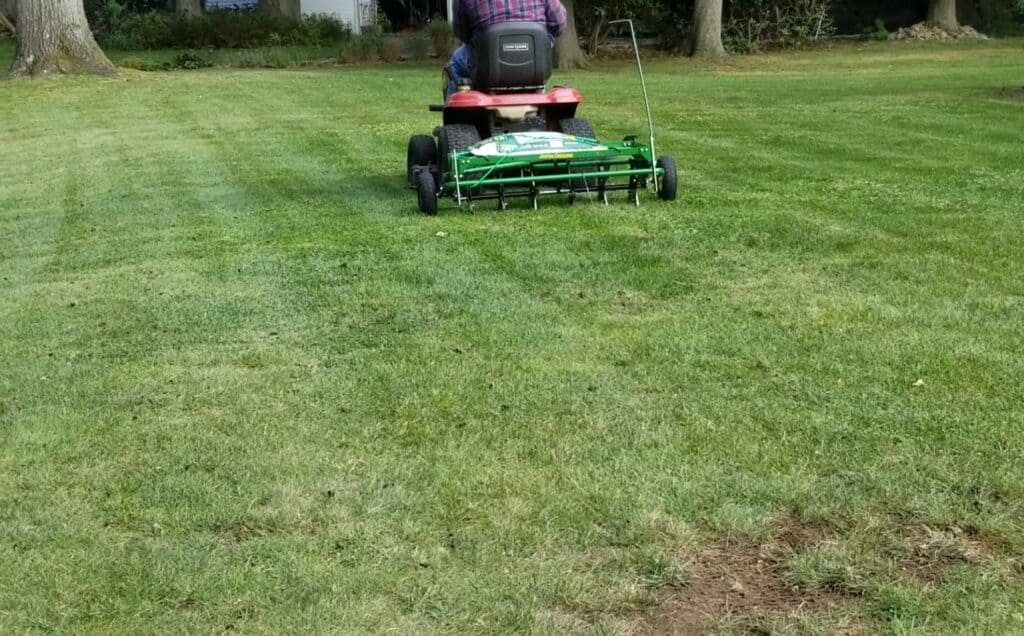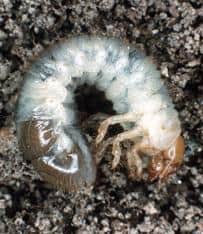
If your lawn shows yellow or dead spots at end of Summer that have not healed come September, you probably have a grub infestation in the soil.
What are Grub Worms and How to Keep Them From Damaging Your Lawn:
Grubs are beetle larvae. These larvae are found on almost every lawn. They have a life cycle and continue generations year after year. They are born of eggs from the Japanese Beetle, enter into the soil, become hatchling grubs in the late summer – July and August, and begin to feed on your lawn’s root system at that time and on into September.
The Grub Time Line:
In the Spring, our lawns are rich and green thanks to proper soil maintenance, a good amount of rainwater, and supportive temperatures. In the Summer, when things get hot, less rainwater (most of the time) and maybe some local watering restrictions, and the dormancy period starts. This is when our lawns are doing everything they can to just hang on. It’s at this time when grub damage will go largely undetected, as the lawn will turn pale by way of the grub damage just as it will when in dormancy. As the lawn emerges out of dormancy in the late summer to early fall, you will find that some of the pale patches will not recover, and, therein lie the grubs.
You see by the diagram above, in the Spring, the grass emerges from Winter dormancy and will rejuvenate. The Grubs are still and will remain there on our lawns. The damage done by the grubs in Spring is about the same as it would be in Summer. However, the damage is mitigated by the Springtime conditions – Springtime temperature, healthy amounts of rain, and some fertilizer. The lawn will easily recover from the grub’s damage.
However, as the Spring season turns to Summer and the supportive water and temperatures are not so advantageous, the grub damage cannot be recovered from so easily. As Summer progresses, our grass can dry out and begin to turn yellow – dormant.

As the Lawn begins to come out of Summer dormancy and begins to return to that rich green color that we all live for, you may begin to see brown spots (dead spots) on the lawn. These dead spots will be more prominent, by contrast, at this time of year as the rest of your grass recovers from the Summer drought. Heartbreaking.
If you were to pull up a tuft of grass, especially around the edges of the dead spots, you would find, at a depth of 2 – 3 inches, grubs hard at work. Some grubs in the soil are completely normal. When they become overly abundant, they will destroy our lawns.
In the late Fall, the point of the first freeze, the grubs are still on the lawn but are beginning to head deeper into the soil to protect themselves from the cold. They hibernate once again.
To sum up the diagram above, in March and April, the grass is in a stage of massive growth. This is to say that while the roots are being eaten, they are also replenishing themselves quickly. There is, therefore, no reason for treating grub worms in the spring.
By June, the grub worms will have gone through their metamorphosis and will be rising out of the soil as Japanese Beetles where they will inflict harm to a great many plant species above the ground. These effects are not a part of this article. We will only be dealing with the turf damage that can be done and avoided with proper care.
However, the flying beetles will now have the opportunity to mate and lay eggs on your lawn, thereby starting the whole cycle again.
How and When to Treat Our Soil for Grub Worm:
We start in June. If you live further south, you will typically begin your treatment in early June. Farther north, late June.
– AN IMPORTANT NOTE –
Grubs tend to stay under the grass that is in full sunlight most of the day. If your lawn is showing distress in more shaded areas, then grubs may not be your problem. If this is the case, you can dig up a small area of your lawn that is showing trouble with a flat spade, to preserve the turf. If you find an excessive number of grubs there, then you should proceed to treat those grubs. If not, however, at that point you can begin to look at diseases, fungi, or other insects as the cause of your lawn yellowing or dying.
The product that I will be using will be Scotts® Grubex®1. It is simple, reasonably priced, and easy to apply. Once applied, be certain to clean up any excess from driveways and walkways.
Scotts® Grubex®1 will require a significant “watering in” immediately after application. Be sure to water at least 1″ to 1 1/2″ to activate the product, as per the manufacturer’s instructions. Please bear in mind that to neglect the watering in is to leave the treatment on the grass and not in the soil where it will be effective. This application, done according to the manufacturer’s instructions, will keep the grub population down to the point of no noticeable damage for up to 4 months which will cover your entire growing season into the Fall.
To apply our treatment, we will need a broadcast spreader, preferably one with edge control to help keep our treatment only on the lawn. I use a Scott’s® Pro EdgeGuard® Broadcast Spreader. I have been very happy with it. Most Home Depot stores will have them available as well at Amazon.com
If you use another brand of the spreader, Scott’s provides an online tool for referencing the corresponding setting for your particular spreader. You can find it here at Scotts.com
If we were to miss our window on the Summertime treatment, we will have the opportunity to use a “curative” solution. This action will not repair the damage done by the grubs this year but will kill off the existing grubs within 24 hours and keep your lawn from further destruction throughout the year and maybe the next as well. This sort of treatment will be covered in a subsequent post.
Of course, missing the window for treatment is not the end of the world The patches can be fixed in the early Fall. I have a video on how I managed to make my repairs last Fall.
Frequently Asked Questions:
- What is the best time to treat for grubs
- The best time for treatment is in early June for the southern states and late June for the northern states
- Will grass grow back after grub damage
- Grass will grow back but, you will have to replant the seed in the fall to make that happen
- Is it too late to treat for grubs
- If you have missed the June window, you can still treat but, the younger the grub, the easier it is for the chemicals to work on them
- Do grubs die in the winter
- No. Grubs hibernate. They will descend into the soil just deep enough to protect them from the cold for the Winter
- Do grubs turn into anything
- There are several species of grubs. Each, once through metamorphosis, becomes a different insect. In this article, I focused on the Japanese Beetle, a very destructive insect to many different plants, not just grass
